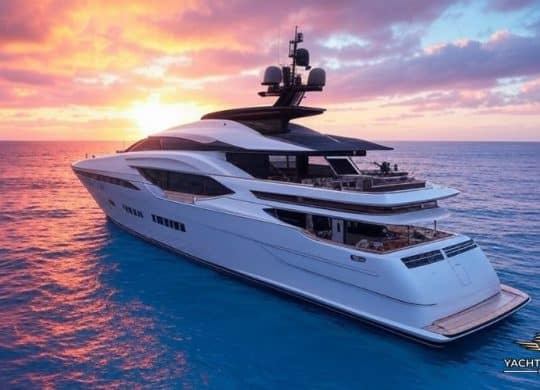How Far Can Different Yachts Travel
| Yacht Type | Typical Size Range | Approximate Travel Range | Specifics |
| Small Motor Yacht | 30-50 feet | 200-400 nautical miles | Good for day trips and short coastal cruises |
| Mid-Size Motor Yacht | 50-80 feet | 500-1000 nautical miles | Comfortable for longer trips, some ocean-capable |
| Superyacht | 80-200+ feet | 1000- 3000+ nautical miles | Designed for extended journeys and ocean crossings |
| Expedition/Explorer Yacht | 70-250+ feet | 3000-6000+ nautical miles | Built for extreme conditions and very long distances |
| Sailing Yacht | 25-50+ feet | Varies greatly* | Distance depends on wind, skill, and boat design |
Factors Affecting Yacht Travel Range
The following factors can affect how far a yacht can travel:
- Fuel capacity and efficiency
- Engine type and power
- Yacht size and weight
- Weather Conditions
Fuel Capacity and Efficiency
The bigger the fuel tank, the farther you can go on a single fill-up. But, just like cars, some yachts are more fuel-efficient than others. A well-designed, well-maintained yacht will squeeze more miles out of each gallon of fuel, even if it has a smaller fuel tank than another, less efficient vessel. For example, when you are looking to rent a yacht in Dubai, it is important to consider fuel efficiency, especially if you are planning a long voyage.
| Yacht Size | Fuel Capacity | Travel Distance |
| 40-foot | 5000 liters | 3000 nautical miles |
| 40-50ft | 500 gallons | 600 miles |
| 75-foot | 11,000 liters | 1500 nautical miles |
| 95-foot | 9000 liters | 1200 nautical miles |
Engine Type and Power
Yacht engines use different fuels, like diesel, gasoline, or electricity. The type of engine a yacht has affects the distance. Some engines are fuel-efficient, while others are powerful but burn more fuel. Modern diesel engines in yachts are often built to be cleaner and use less fuel than older ones.
There are even companies like Greenline that specialize in hybrid yachts, which can use a combination of diesel and electric power or even solar energy. Here are the most popular yacht engine types and their fuel consumption capacities.
| Yacht Engine | Fuel Consumption |
| Yanmar 4JH57 | 2.2 liters/hour at 2800 RPM |
| Yanmar 3GM30F | 4.5 liters/hour at full load |
| Yanmar 2GM | 2.5 liters/hour at maximum power |
| Yanmar 2GM20F | 3.9 liters/hour at rated output |
| Greenline 33 Hybrid | 4 liters/hour at 7 knots |
| MerCruiser 3.0 MPI/TKS | 10 gallons/hour at 2500 RPM |
| MerCruiser 4.3 TKS | 16 gallons/hour at 2500 RPM |
| MerCruiser 4.3 MPI | 18 gallons/hour at 2500 RPM |
| MerCruiser 5.0 MPI | 18.5 gallons/hour at 2500 RPM |
| Beta 20hp | Between 1 and 1.3 liters/hour |
| Cummins QSL9 | 54.3 liters/hour at 1800 RPM |
Hull Design
According to the 2022 Conference Paper by the International Symposium on Energy Sustainability and Management, if the hull is slim and smooth, it can cut through the water more efficiently, improving fuel efficiency and increasing speed. On the other hand, a wide and flat hull might be faster, but it could also consume more fuel because it creates more drag in the water.
Weight on Board
Every yacht has a maximum displacement, which is the total weight it can carry while still floating safely. It includes the weight of the yacht itself, crew, passengers, supplies, etc. As a yacht gets closer to its maximum displacement, it sits lower in the water.
So this increases drag, making the yacht slower. A 2021 study published by Link Springer mentioned that while the extra weight itself does not directly consume additional fuel, the increased drag and slower speed indirectly affect fuel efficiency.
Weather Conditions
Weather plays a massive role in how far a yacht can travel. For example, stormy weather makes it harder for yachts to move forward. It means they won’t get as far as quickly. On the other hand, calm weather is a yacht’s friend because the engines can work more easily, letting the yacht travel further.
How To Calculate Yacht Travel Distance
The formula to calculate your yacht’s travel distance is:
D= S x T
- D represents the Distance traveled (in miles, nautical miles, or kilometers, depending on your preference).
- S is the yacht’s speed (miles per hour, knots, or kilometers per hour).
- T is the Time spent traveling (in hours).
Final Words About Yacht Traveling Distance
A yacht’s travel distance is a complex calculation. Consider your yacht’s fuel capacity, efficiency, weight, and the weather conditions you expect. Smaller yachts are great for shorter trips, while superyachts and explorer yachts are built for longer journeys. You plan your voyage using the distance formula (D=S x T).






